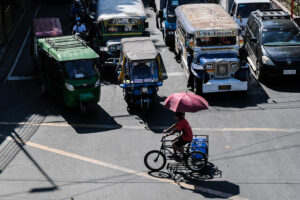
Personal mobility and public safety
On April 15, authorities started restricting certain types of light vehicles from major roads in Metro Manila. The ban was imposed particularly on tricycles, light electric vehicles such as e-bikes and e-scooters, and other electric personal transport. The ban supposedly aims to ensure road safety and reduce the number of accidents involving these vehicles.
In Singapore, as reported in the Straits Times, there are also discussions about the regulation of what they call personal mobility aids, including speed restrictions and medical certification for persons with disabilities (PWDs) using light electric vehicles. In both cases, here and there, the issues revolve around urban mobility and safety.
The debates highlight the tension between improving road safety and promoting inclusive mobility in densely populated urban environments. The regulatory objective is to curtail misuse or abuse and promote public safety. In Singapore, the regulation advocate is the Active Mobility Advisory Panel (AMAP). Here, it is the Metro Manila Development Authority (MMDA).
The contention is that regulations have a negative impact on accessibility and individual mobility, particularly of some sectors relying on these nontraditional solutions. The argument is that restrictions disproportionately affect the working class, students, those with disabilities and small business operators who rely on light electric vehicles for daily commuting and economic activities.
The issue points to the challenge of balancing safety and inclusivity. To ensure safety, segregated lanes and clear demarcations are suggested, instead of outright bans. Critics of the ban also point out that improving infrastructure to accommodate all forms of mobility, rather than restricting them, would be a more effective and equitable solution to traffic congestion and safety.
Locally, the MMDA road ban is also seen as being at odds with the Electric Vehicle Industry Development Act, which promotes the use of electric vehicles to reduce urban air pollution. Similarly, in Singapore, while the focus is on safety and proper usage of light electric vehicles as personal mobility aids, there is a call for regulations to also consider environmental sustainability and the promotion of energy-efficient vehicles.
Moving forward, perhaps regulations should consider integrated solutions that satisfactorily address safety, inclusivity and environmental impact. For instance, much like the use of dedicated bicycle lanes and pedestrian pathways, perhaps something similar can be considered to accommodate light electric vehicles. But there should be speed limits and usage guidelines.
More important, public transportations systems should be improved to offer options that provide viable alternatives to light electric vehicles and address concerns about accessibility and connectivity. If there are safer, more convenient and cheaper alternatives to e-bikes and e-scooters, as well as cars, then more people will most likely take public transportation.
The crux of the matter is that necessity heeds no law. Desperate people take desperate measures. And those who need to get from one point to another, especially as a matter of livelihood, will be ready to violate rules and risk penalties. This is also because traffic enforcers will not be around 24-7. In short, there will be “windows of opportunity” for people to use their light electric vehicles even on banned roads.
I believe that these vehicles may be allowed on some public roads, but there should be clearer guidelines on where and how they can be used. Regulations particularly for personal mobility devices, which include e-scooters, hoverboards and other similar transportation tools, should be realistic and consistently enforced. For instance, safety helmets are required.
But any light electric vehicles smaller than a motorcycle should have special lanes on national roads, or any city road for that matter, much like bicycles. They may be allowed on private, subdivision and maybe village roads. But on any other public road, these should have specially built pathways beside or alongside sidewalks or bicycle lanes.
Speed limits should also be set for every mobility device. Also, any vehicle type allowed on public roads should be registered, issued license or registration plates, and the owner must have insurance for accidents. Light electric vehicle users must be licensed and age limits set. Sidewalks should be limited to pedestrians, wheelchairs and low-speed personal mobility devices.
Obviously, any regulatory action should be preceded by a process of harmonizing standards. Light electric vehicles and personal mobility devices should be covered by global definitions and technical specifications. Most of them are produced abroad. There should be Philippine National Standards to cover these mobility devices.
Also, rules should be dynamic and consider the needs of the times. Given the pace of technological change, modes of transport can change very quickly. Big changes in infrastructure are always difficult to undo. Policy makers should always be ahead of the curve and future-proof regulations to ensure they lead to as little disruption as possible at every change point.
The challenge, of course, is to always ensure that rules and regulations consider public safety, decongestion, the diverse needs of urban dwellers and road users and promote an inclusive approach to zoning and city planning. The overall aim is to promote long-term environmental and social goals, ensuring that cities remain healthy, livable and efficient.
More important, pedestrians should always be a part of the equation. Cities should, first and foremost, be walkable. The rights of motorists and users of light electric vehicles and other mobility aids should not take priority over those of pedestrians. Walking is the most basic form of mobility, and in any public space, pedestrians are the most vulnerable. They should have the most protection under the law.
But such protection requires reciprocity by way of pedestrians being mindful and respectful of other road users. Mutual respect is necessary. Pedestrians should also be responsible users of public space. If erring motorists are penalized, there should be penalties for erring pedestrians as well. In this regard, effective pedestrian and driver education are the most important interventions.
Marvin Tort is a former managing editor of BusinessWorld, and a former chairman of the Philippine Press Council.



